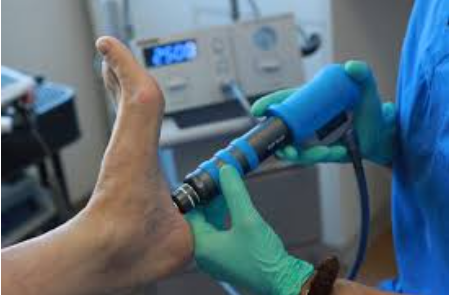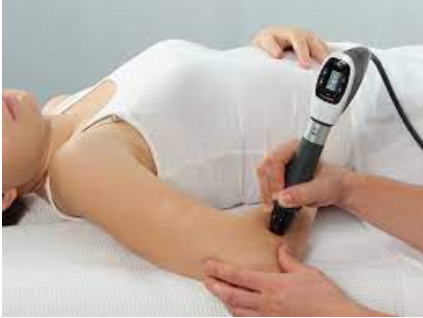Extracorporeal Shockwave Therapy
What is it?
● ECSW is a modality used to treat chronic musculoskeletal issues usually
involving a tendon and its insertion into the bone (tendinopathy/ enthesopathy).
● It is evidence based, cleared by the FDA and considered safe with very few side
effects.
Who is a candidate for shockwave therapy?
● People with chronic or persistent musculoskeletal tendinopathies.
Especially those who have not responded to traditional treatments and
want to avoid more invasive treatments (such as surgery).
What are some common musculoskeletal conditions that can be treated with shockwave? 1
● Plantar fasciitis / Fasciosis
● Lateral epicondylitis (tennis elbow)
● Medial epicondylitis (golfer’s elbow)
● Calcifying tendinitis of the shoulder (rotator cuff)
● Patellar tendinopathy
● Achilles tendinopathy
● Greater trochanteric pain syndrome (lateral hip pain)
● Delayed bone healing
● Tibial stress syndrome (shin splints)
How does it work?
● The shock waves generated during treatment penetrate the affected tissues and
trigger a cascade of biological responses (a form of mechanical transduction)
23
● Shock waves are sound waves that consist of a positive and negative wave.
● The positive phase produces mechanical forces while the negative phase
generates cavitation 4
that produces a second wave of shockwaves. These waves act at the cellular, molecular and biological levels to purposely create an inflammatory response which then
stimulates tissue repair and cell growth.
Benefits of ECSW Therapy:
● Accelerated healing: Shockwave therapy speeds up the healing process by
stimulating the body’s natural repair mechanisms. 5
● Pain reduction: it is thought that shockwaves act on pain regulation systems in
the body to release endorphins and analgesic chemicals which can then lead to
an increase in a patient’s pain threshold. 6
● Non-invasive: the treatment is performed as a non-surgical, outpatient procedure.
Costs, recovery time, and risks are all lower compared to surgical procedures.
What to expect during treatment?
● Our therapists begin with a thorough evaluation of your injury.
● Treatments typically last about 5 minutes (with some added ‘prep time’ so count on 10-15 min total). Patients may feel mild/moderate discomfort during the treatment. This is normal and usually resolves quickly.
● We recommend weekly treatments (or every 5-10 days) for a total of 5 treatments.
● Potential side effects include: pain, redness, and superficial hematoma. 7
● It may be used as a stand-alone treatment or in conjunction with physical therapy (preferred!).
- https://shockwavetherapy.org/indications/
- Simplicio, C. L., Purita, J., Murrell, W., Santos, G. S., Dos Santos, R. G., & Lana, J. F. S. D. (2020). Extracorporeal shock wave therapy mechanisms in musculoskeletal regenerative medicine. Journal of Clinical Orthopaedics and Trauma, 11, S309-S318.
- https://en.wikipedia.org/wiki/Mechanotransduction
-
Tomer , A., John-Chu , C., Safadi, S., Ager, A., & Jackson, K. (n.d.). Extracorporeal Shockwave Therapy . physio-pedia.com. https://www.physio-pedia.com/Extracorporeal_Shockwave_Therapy#:~:text=Principles%20of%20Shockwave%20Therapy,-Shockwaves%20are%20transient&text=Significant%20tissue%20effects%20include%20cavitation,new%20bone%20or%20tissue%20formation.
- link-https://www.ncbi.nlm.nih.gov/pmc/articles/PMC6029898/
- link-https://www.ncbi.nlm.nih.gov/pmc/articles/PMC6029898
- https://www.ncbi.nlm.nih.gov/pmc/articles/PMC7608508


